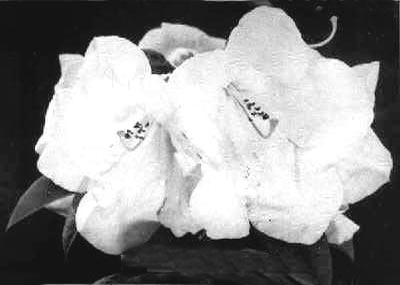QBARS - v3n3 Rhododendron taggianum
Rhododendron taggianum
D. W. James

|
|
Fig. 3.
R. taggianum
Overstreet photo |
Rhododendron taggianum is a member of the series Maddenii, subseries Megacalyx, found in the region of North-East Upper Burma: Western flank of the N'Maikha-Salween Divide, near Pan-ti-Lo, at an elevation of 10,000-11,000 feet, on margins of open conifer forests and amongst scrub on rocky slopes. This places it in that group of rhododendrons which must be given some winter protection, although there is evidence that the plant itself will stand considerable cold, except for possible bud damage, in Northwest gardens.
Normally the plant is a rather leggy or vining grower but by selection of the better seedlings, a more sturdy form has been found. The foliage is most attractive, being rather long and pointed, of a soft silvery green color, and evenly spaced on the branches. The new growth is continuous for the entire growing season, seeming to have no terminal as do most rhododendrons, and instead of completing a growth then possibly making a second growth, it will add a foot or more all in one operation.
The plant which bloomed for us in 1949 is from a selected form, scions of which were sent from England in 1947, and grafted onto vigorous ponticum understock. The grafts were successful, and made a rank new growth some eighteen inches high the first year. In 1948 the growth was probably two feet more, straight up, so it was deemed advisable to pinch the plants back for better branching.
Curiosity however, made us let one plant alone, in the hopes that it would bud, which it did beautifully, with a bud in the dormant stage, the size of a small hen's egg. Any rhododendron enthusiast can well imagine the interest and excitement accompanying such a phenomena and the care that bud was given during the miserable winter of 1948-49. The plant was kept in a cool greenhouse, where the only effort to regulate the temperature was to keep it above the freezing point.
In April, when the enormous bud began to swell, there was great speculation as to what sort of flower would emerge. The description given in the Species Book was that it would be three flowered, white with a yellow blotch, and fragrant, which In this case was certainly an understatement.
When the truss of flowers began to open (Fig. 3), the buds were tinted pink, but when fully open, eight enormous flowers, each measuring a good six and one half inches across, and six inches long, with the texture of a magnolia, perfectly white except for a very small blotch of yellow In the throat, and deliciously fragrant, lay in a beautiful crown on top of the four foot stem. In many ways it resembled a giant lily. It is an impossible task to describe such a flower adequately, or to give to the reader a real understanding of the outstanding dignity and grandeur of Rhododendron taggianum . The book on Species of Rhododendron states, "This will probably prove to be the gem of Mr. Forrest's 1925 collection," and since seeing the plant in bloom it is easy to believe the statement to be true.
R. taggianum was given an F. C. C. in 1943, and has been a winner A its class a number of times at the Chelsea Show in England.
